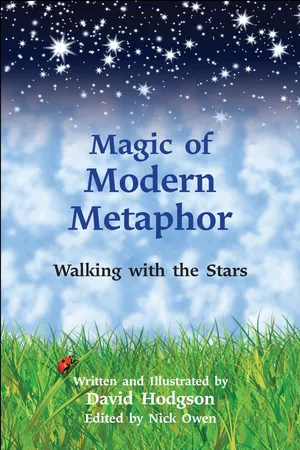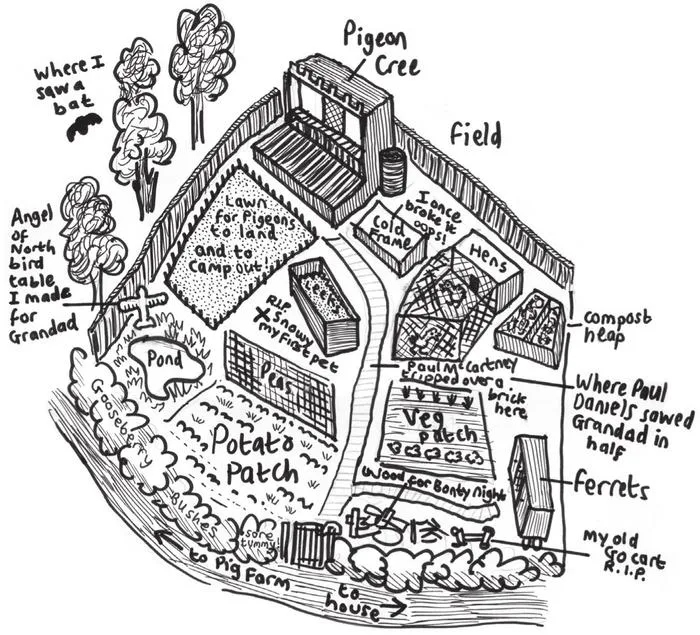
- 208 pages
- English
- ePUB (mobile friendly)
- Available on iOS & Android
eBook - ePub
About this book
A collection of stories for teachers, trainers, parents and thinkers sharing ancient wisdom through a modern relationship between grandson and grandad. Warm, funny and inspiring stories to be read individually or as a whole story by adults or children.
Frequently asked questions
Yes, you can cancel anytime from the Subscription tab in your account settings on the Perlego website. Your subscription will stay active until the end of your current billing period. Learn how to cancel your subscription.
At the moment all of our mobile-responsive ePub books are available to download via the app. Most of our PDFs are also available to download and we're working on making the final remaining ones downloadable now. Learn more here.
Perlego offers two plans: Essential and Complete
- Essential is ideal for learners and professionals who enjoy exploring a wide range of subjects. Access the Essential Library with 800,000+ trusted titles and best-sellers across business, personal growth, and the humanities. Includes unlimited reading time and Standard Read Aloud voice.
- Complete: Perfect for advanced learners and researchers needing full, unrestricted access. Unlock 1.4M+ books across hundreds of subjects, including academic and specialized titles. The Complete Plan also includes advanced features like Premium Read Aloud and Research Assistant.
We are an online textbook subscription service, where you can get access to an entire online library for less than the price of a single book per month. With over 1 million books across 1000+ topics, we’ve got you covered! Learn more here.
Look out for the read-aloud symbol on your next book to see if you can listen to it. The read-aloud tool reads text aloud for you, highlighting the text as it is being read. You can pause it, speed it up and slow it down. Learn more here.
Yes! You can use the Perlego app on both iOS or Android devices to read anytime, anywhere — even offline. Perfect for commutes or when you’re on the go.
Please note we cannot support devices running on iOS 13 and Android 7 or earlier. Learn more about using the app.
Please note we cannot support devices running on iOS 13 and Android 7 or earlier. Learn more about using the app.
Yes, you can access Magic of Modern Metaphor by David Hodgson, Nick Owen in PDF and/or ePUB format, as well as other popular books in Education & Education General. We have over one million books available in our catalogue for you to explore.
Information
Part I
Introducing the Stories
‘We were making the future,’ he said, ‘and hardly any of us troubled to think what future we were making. And here it is!’
The Sleeper Awakes, H. G. Wells

Introduction
The Angel of the North
On an exposed windy hillside in Gateshead an individual stands confidently over a community. When erected in 1998 the Angel divided local opinion; awe on one side and ‘couldn’t a million pounds be better spent?’ on the other.
The Angel has stood for over ten years now and it makes a difference. Once something exists it can’t not make a difference. It is part of the landscape but still seems to float above it. It can inspire and surprise each time you see it. I have driven by it many times on my way to a work event or on a family outing and its power is palpable. In my little bubble, in my little car, with my little worries I’ve caught a glimpse of the sun on a wing or the mighty silhouette against a huge tarmac grey sky and I’m taken out of my bubble, if only for a moment. A moment is long enough to contemplate better questions.
The Angel represents an investment in art and imagination over the practical and ‘real’. When combined, these two become a powerful force. Although the initial million pound price tag seemed excessive to many, an original bronze maquette (model) owned by Gateshead Council was valued at one million pounds on an episode of Antiques Roadshow, the highest valuation given to any object in the history of the programme. The true value of things is not always obvious. Time changes and places change and so can people, individually and as communities. People often feel threatened by change. Yet only when we change do we grow and develop.
The Angel changes slowly. Its rusty colour is mellowing with age. It was built to last for a hundred years. Soon after its installation, the Angel was adorned with a huge black and white striped football shirt bearing the name ‘Shearer’ and the number 9, though only for twenty minutes until police arrived to remove it. The names of future North-Eastern heroes are as yet unknown but the Angel will be there as their stories unfold.
When Antony Gormley is asked to explain his Angel of the North he offers three thoughts: to remember the generations of coal-miners who worked in the darkness beneath the hill for two hundred years, to highlight the change from the industrial age to the information age and as a focus for us to explore our hopes and fears.
Gormley’s overall theme of a community seeking an identity through changing times resonates with everyone at an individual level. As we grow up we search for our own identity within our community, and this collection of stories reflects our individual journeys.
As we immerse ourselves in information, as a species, we could do well to remember that our own senses bombard us with perhaps three million pieces of information per minute. As individuals we filter and use only a small amount of this information. Understanding this filtering process and using it wisely is more useful than gorging on information.
Occupational psychologists studying human performance have explored the impact of training in four areas: information, skills, attitude and habits. Their research suggests that business generally concentrates on information and skills when it is attitude and habits that have a greater long-term impact on performance. Although attitude and habits are more difficult to influence, stories can offer a gentle yet profound route to challenge and change them.
Education, too, has increasingly focused on squeezing information and skills into a crowded curriculum. Perhaps we should remember that schools were originally formed in Ancient Greece to allow students and teachers the opportunity to share their ideas and perceptions. Such a two-way process grows attitude and habits. The word education derives from the Latin educare meaning ‘to draw out’. We are not blank slates, and stories are a rewarding method for drawing out the wisdom within all of us.
The majority of our attitudes and habits are formed as we grow up. If we are lucky children we are surrounded by angels influencing us in positive ways. Siblings, peers, parents, teachers, neighbours and communities are benign or malevolent guides. Grandparents, at their best, are the most powerful angels of all because their influence can spread through time, acting as a bridge linking the generations.
When we interpret stories we can’t be wrong. We create meaning that is right for us in that time and place. The stories presented in this collection offer the reader an opportunity to explore their attitudes and habits. Once we are able to gain greater clarity in these areas we can better develop our knowledge and hone our skills to be effective individuals and valuable members of our communities.
Ten methods for getting the most out of this book
Stories are the most important thing in the world. Without stories, we wouldn’t be human at all.
Philip Pullman
I’d like to encourage you to write your thoughts on the pages of the book itself (unless you’re in a bookshop as this can annoy staff). This is a great way to personalise the stories.
And if you do turn out to be famous, the scribbles you make in this book could make it far more valuable to wealthy collectors in the future. However, any financial benefits will probably be enjoyed by your children or grandchildren some time after you’re gone.
A psychologist studied two Native American tribes that lived side by side. One tribe allowed their infants to crawl freely and the other tribe restricted their movements. The tribe that allowed their children freedom were more advanced in terms of arts and crafts, tools used, writing and performing as a group. When we interact with our environment we learn more. I recommend you interact with the stories that follow.
Method 1
Relax. Read a few stories and stop when you find something particularly interesting. Reflect.
On a piece of paper write down five thoughts that occur to you. They could include: the meanings of the story, personal memories, how the story relates to things currently going on in your life or anything else. Return to your thoughts later.
Method 2
Read two stories (random or consecutive) and think of a way to link them.
Method 3
Read a story and ask yourself: How can I apply this in my own life?
Method 4
Read a story and ask yourself: What would I do next?
Method 5
Identify someone you admire and read a story as if you were that person. Then ask yourself what they would think of the story.
Method 6
Ask yourself: How would I change or improve a story?
Method 7
Ask yourself: What are my memories from childhood (people and/or events)?
Method 8
Roll a dice and then summarise the story in that number of words.
Method 9
Ask yourself: With whom would I like to walk? Next time you go on a walk imagine they are with you. Have a conversation (but best to do it inside your head unless it is a secluded walk).
Method 10: The group method
It’s not just good to share your sweets. Discuss the stories with a friend or group of friends if you’re lucky enough to have more than one. There is a great deal of research confirming the benefits of sharing our thoughts, ideas, opinions and dreams.
Part II
The Stories
If the doors of perception were cleansed everything would appear to man as it is, infinite.
William Blake

1. Swapping allotments
While digging some compost into the area where potatoes would be planted later in the year, Jack asked Grandad how it was that he had the best allotment. It certainly seemed to be the biggest and best, for it was situated at the end of the row bordered by a field, a hedgerow of gooseberries and a sm...
Table of contents
- Cover
- Praise for the Magic of Modern Metaphor
- Title Page
- Dedication
- Foreword
- Acknowledgements
- Table of Contents
- Part I : Introducing the Stories
- Introduction
- Part II : The Stories
- Part III : Interpreting the Stories
- Further reading
- Copyright